What Do Wild Dogs Eat? Vegetables Or Meat?
Introduction: What Do Wild Dogs Eat?
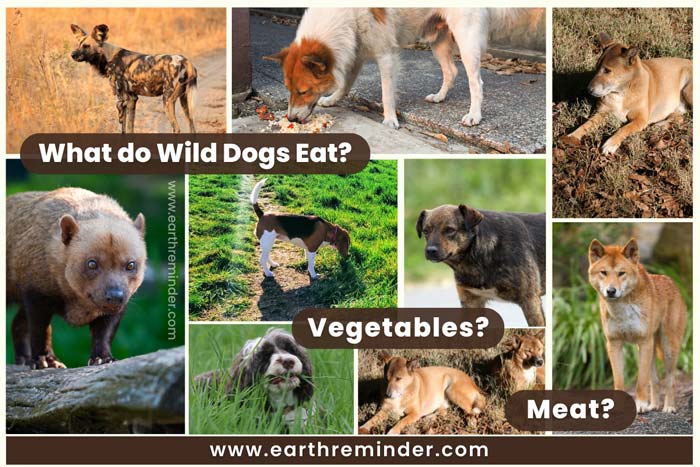
Wild dogs are flexible eaters and will eat a wide variety of foods depending on what is available to them. There are various wild dogs, and they all have different food preferences.
When speaking of dogs, most people only think about domestic breeds. It is because dogs are some of the most common household pets in the world today. Dogs are descendants of wolves, so you naturally expect these two animals to have similar diets. Everyone knows that wolves are carnivores, so are dogs same too?
Although their ancestors are carnivores, dogs today are omnivores. They eat different types of food, including meat, carbohydrates, vegetables, fruits, and special dog food.
However, do domestic dogs and wild dogs follow the same diet? What do wild dogs eat? Do dogs eat vegetables in the wild? Here is an in-depth explanation of wild dogs and their diet.
Table of Contents
Facts About Dogs in the Wild
As expected, dogs in the wild typically eat raw meat. They also get a considerable portion of their nutrition from different food sources.
However, they are not obligated to stick to a carnivorous diet. Dogs bodies can handle a variety of food, including fruits, vegetables, plants, herbs, and meat. Consider exploring options such as probiotics chews for dogs to support your pet’s digestive health and overall well-being, especially if they have specific dietary needs or sensitivities.
Wild dogs can benefit from a fasting period that helps detoxify their bodies. It also gives their digestive system a break. This fasting period can extend from 12 to 24 hours.
Also Read: Why Wild Animals Should Not Be Pets?
Characteristics Of Wild Dogs
Here are a few of the characteristics of wild dogs.
- Wild dogs can live alone or in packs.
- They are seasonal breeders.
- Meat is a clear top choice among wild dogs.
- Wild Dogs have powerful legs and can run long distances at high speeds (up to 44 miles per hour).
- They prefer fresh food over old food.
- They are highly intelligent and smart animals, able to communicate and cooperate with each other in order to catch their prey effectively.
Before moving on to the question of “what do dogs eat in the wild”, it is first necessary to understand their types. This will help you understand their eating habits better.
Types Of Wild Dogs
Currently, wild dogs are found in different parts of the world. Wild dogs in the early days have adapted to their circumstances in various ways, resulting in various species. The following is a list of various wild dogs so that you can identify the differences between them.
Free-Roaming Dogs
As the name denotes, free-roaming dogs are dogs that have been given some amount of freedom to roam around.
They have a human owner, but they’ve been given the freedom to run freely. Although technically they aren’t wild dogs, but their eating habits can still be instructive.
There are a variety of breeds, shapes, and sizes of these dogs. One of the main features that distinguish them from other wild dogs is the existence of a collar. Most free-roaming dogs wear a collar, whereas only a few do not wear one.
Also Read: How to Take Care of Animals?
Stray Dogs
Stray dogs are mostly similar to free-roaming dogs, except they don’t have any owners. They don’t belong to a family or have a home to call theirs. They are typically found roaming in the streets.
Stray dogs might have once been free-roaming dogs who eventually wandered off at some point. Sometimes, owners also abandon their free-roaming dogs, who ultimately become stray dogs.
They are typically friendly with people. However, they may trust humans less because they are used to living on their own.
According to IPetGuides, stray dogs can be well-trained and domesticated due to their friendly nature and willingness to get along with humans. It only takes a little bit of time and effort to do this.
Dingoes
There is some confusion and vagueness about the origin of dingoes. However, they are descendants of domestic dogs who, at one point, roamed the wild on their own. Thus, they belong to the category of wild dogs.
Dingoes have been in existence for about 3000 years or more. They are used to living in various habitats and under different pressures than their domestic counterparts. In terms of appearance, dingoes are typically medium-sized, tan-colored, shepherd-like dogs.
Feral Dogs
Feral dogs live entirely independently from humans. Many feral dogs have been born in the wild and live their entire lives in it.
Therefore, feral dogs fear humans because they have not been exposed to socializing. They spend their entire lives in the wild with little to no interaction with humans. Thus, they don’t know how to bond with people.
The fear of humans is what differentiates a feral dog from a stray. Stray dogs learn to trust people over time with experience. However, feral dogs remain afraid of people and try their best to avoid them entirely.
Feral dogs are rare, adding up to a mere 2.5% of the world’s dog population that roams freely.
African Wild Dogs
Lycaon Pictus, or African wild dogs, are amazing animals that most researchers select to research. Their diets and hunting behaviors are unique, which is the main reason for this selection.
They are native to the sub-Saharan region and are relatively large dogs. Typically, these dogs weigh between 40 and 79 pounds, although males tend to weigh slightly more than females.
However, African dogs are not your typical domestic dog. They are distant relatives to the carnivore pet you have at home.
African wild dogs live in packs, usually with five to twenty members. They are endangered animals. Approximately 6,600 wild dogs live in the wild, of which nearly 1400 are mature.
New Guinea Singing Dogs
New Guinea singing dogs are wild dogs native to Papua New Guinea. They have unique vocalizations, including howling, yodeling, and other sounds that mimic human speech.
Their nature is quite similar to that of dingoes, due to their similar diets. They also look alike, except that singing dogs are shorter and have blacker heads. They weigh between 25 and 30 pounds.
New Guinea dogs have black or dark brown coats with white markings. Their pointed ears are also one of their striking physical traits. Although they originated as wild dogs, they are now domesticated and seen as pets in homes.
Bush Dogs
Bush dogs live in the forests of Central and South America. They are small dogs with reddish-brown coats and bushy tails. Additionally, they are known for being very friendly and social animals, and often form close bonds with other members of their pack.
What Do Wild Dogs Eat?
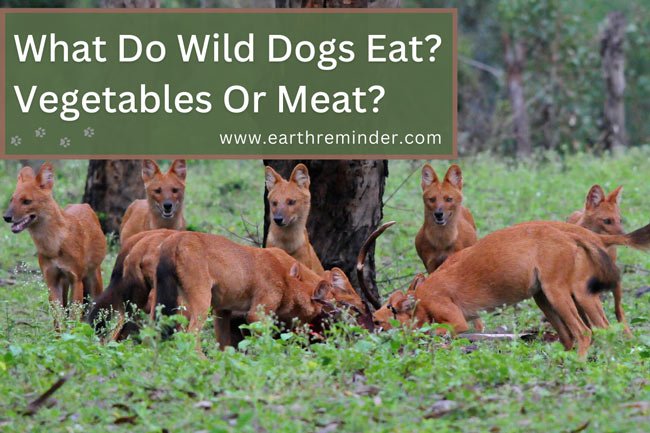
There are a few differences in terms of the food that the above wild dogs eat. Most of them eat whatever they manage to find in their surroundings.
Wild dogs hunt in packs, so their main meal is meat. However, do dogs eat vegetables in the wild? The answer is that they also eat fruits, vegetables, and other plant matter that they can find nearby. Below are some of the common types of food that wild dogs eat:
Bugs
Most dogs are known to eat bugs, and wild dogs are the same. They mostly prefer to eat large, slow bugs that are easy to catch. Therefore, they don’t have to tire themselves much trying to catch bugs for food.
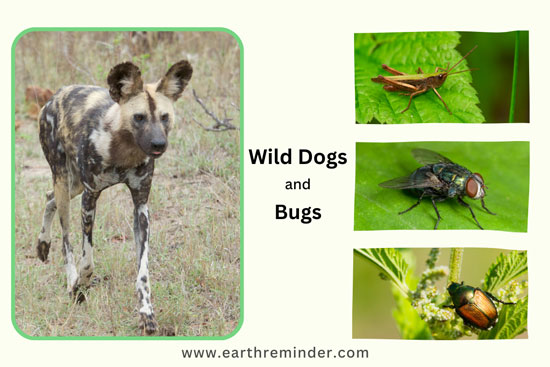
Wild dogs are witty and can easily catch bugs that fly right above their noses in a flash. It is something that comes naturally to them. Bugs can include cockroaches, beetles, grasshoppers, flies, caterpillars, etc.
Once they see a fly buzzing past it, it naturally tends to go at it. It is more of a natural instinct than an attempt to fulfill their hunger.
Carrion
The term “carrion” refers to the carcasses of dead animals. Dogs often come across dead animals in the wild, which is also one of their primary food sources.
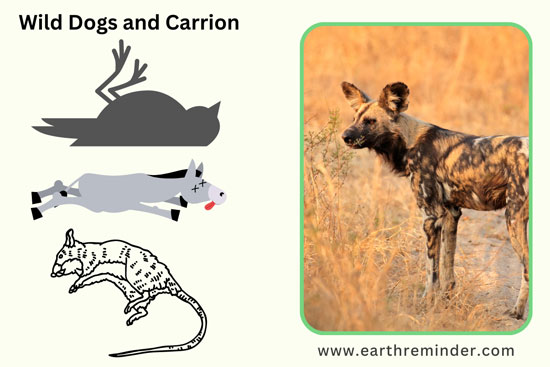
Carrion is a vital food source for carnivores and omnivores living in the wild. It’s something that wild dogs come across all the time. However, roadkill is known to be the most consistent source of this kind of food.
Small Animals
Wild dogs consume many small animals they can find in their habitats. They are a common source of food for many wild animals.
For instance, coyotes feed mainly on mice, chipmunks, rats, squirrels, and similar animals. The same is true when it comes to wild dogs.
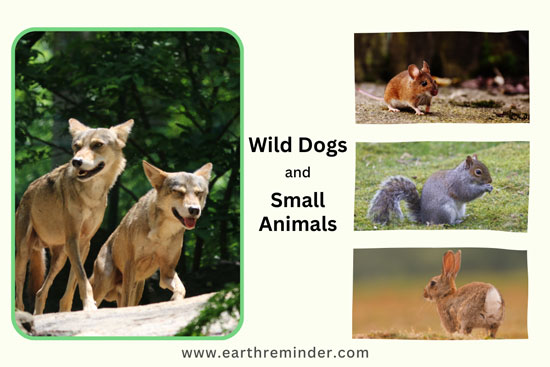
Occasionally, geese and ducks also become prey to wild dogs that may stumble across these animals. However, wild dogs typically hunt on geese and ducks mostly when they are injured, as they cannot escape at such times.
Large Animals
Although it may not be common, wild dogs occasionally prey on large animals. Some of the large animals that wild dogs eat are sheep, deer, goats, and small pigs.
In most cases, farm owners think their livestock has been killed by wolves or coyotes when they actually have been attacked by wild dogs.
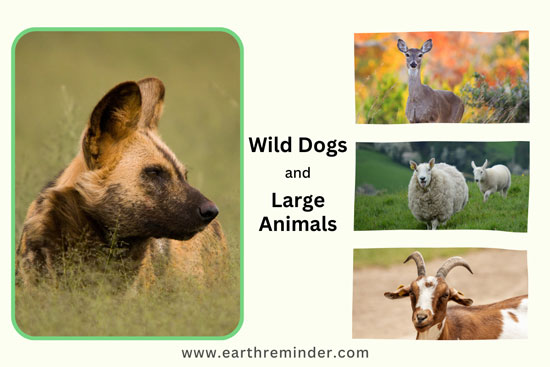
Please note that, if you are a wildlife management official, you must know how to distinguish between livestock killed by wild dogs and those killed by wolves or coyotes. In this way, you can help the farm owners efficiently.
Vegetables
Yes, it’s true! Wild dogs sometimes eat vegetables. Wild dogs are omnivores, unlike wolves, which are carnivores. So, wild dogs will eat anything from meat to vegetables and fruits. Wild dogs like to eat grass and leafy green vegetables found in their surroundings.
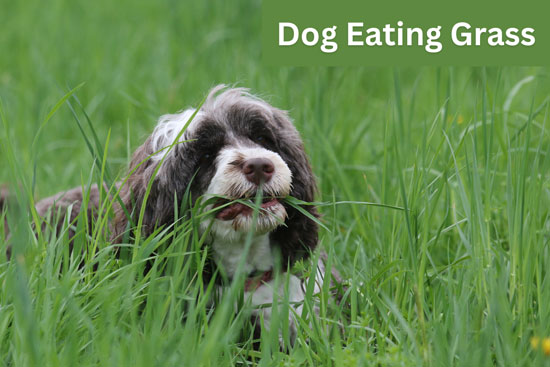
Another thing is that wild dogs tend to consume grass inadvertently. They might often ingest grass while trying to eat a dead squirrel on the ground.
Fruits
Fruits are also another food source for wild dogs. They mainly eat a variety of fruits that grow in the wild. These dogs eat common wild fruits, including raspberries, blackberries, cherries, and persimmons.
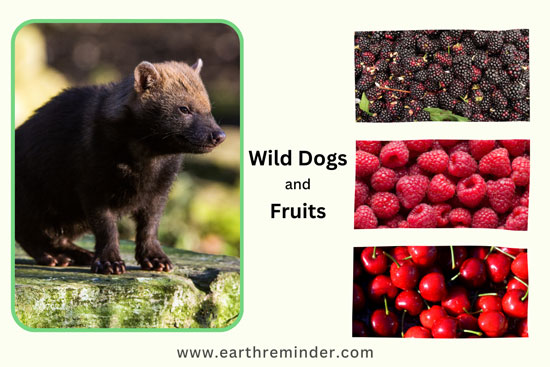
Besides wild fruits, wild dogs also eat other fruits, such as peaches, mangoes, and pears, that people cultivate in home gardens.
Trash
Human waste is an essential food source for wild dogs. That is why you see them searching through trash bins everywhere.
A majority of trash consists of the food humans throw away daily. Wild dogs feed on these leftovers through which they find nutrition. You always see so many dogs with their heads in trash cans to fill their tummies.
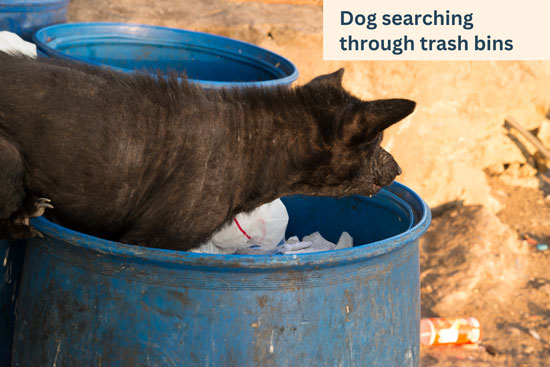
In captivity, however, their diet is generally more controlled and includes dry food specifically designed for canine carnivores.
What Dogs Don’t Eat in The Wild?
As much as you know what wild food dogs eat, it’s also essential to know which foods they don’t consume. One thing is that they may not eat every day.
Wild dogs can stay without eating for a day or two or even longer. It depends on several factors, including the size of the pack, where they live, the season, and the available prey. A healthy dog can even stay up to a week without food.
Generally, wild dogs cannot digest grain properly, so they simply don’t eat it. Even if digestion is possible, dogs cannot convert it to sugar and store it for later use.
But according to the study, free-ranging dogs are able to digest starch, which they obtain from human waste. A study found that dogs roaming free in Zimbabwe regularly consume sadza, which is porridge.
Wild Dogs Diet Changes with Time and Location
Among wild dogs, there is a lot of variation in eating patterns and behavior. Each has its ways and preferences, which it sticks to. So, one wild dog may be digging through the trash can in search of food, while another might prefer preying on squirrels or chipmunks in the forest.
Also, the place and climatic condition in which these dogs live also impact their food choices. Their feeding patterns and food sources also change according to the time of the year.
For example, bugs will be available mainly in the summer, while something like trash is available all year round. Dogs also enjoy winter-ripening berries during the winter, when they are widely available.
How Do Wild Dogs Get Water?
Regular access to water is essential for wild dogs just as much as for domestic dogs. It helps keep them healthy and is vital for the body.
Common water sources for wild dogs are lakes, streams, rivers, and ponds. Wild dogs sometimes will even drink water found in puddles and lick the dew off plants in the morning.
In other areas where more people live, occasionally, wild dogs will drink from bird baths and other objects with water on them. The other source of water for wild dogs is their food. Meat, vegetables, and fruits have water that helps keep wild dogs hydrated.
They often eat raw meat, which is why they die at a young age. Study findings indicate that only 19% of wild puppies live past six months of age. They are also more prone to early death due to encounters with predators or being hit by a vehicle.
Final Thoughts: Dogs Eating in the Wild
Several myths exist about what wild dogs eat, including the idea that they only eat meat. It is actually quite common for wild dogs to consume vegetables as well. Wild dogs are omnivores. Although meat is still their primary source of nutrition, vegetables and fruits can also provide them with essential vitamins and nutrients. Wild dogs don’t need to eat every day. They can survive a few days without food. They also need access to water, which is essential for their health. So, the next time you see a wild dog, make sure to offer it your leftover vegetables and water!